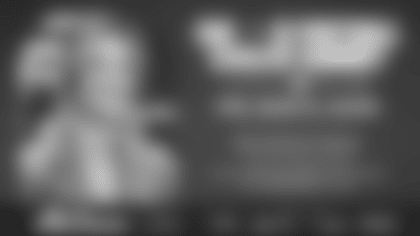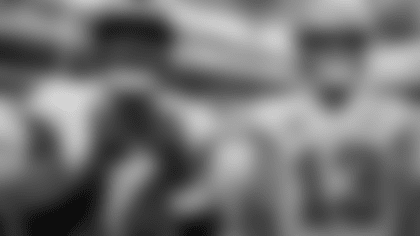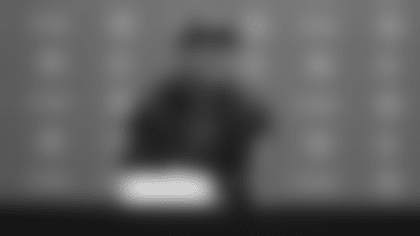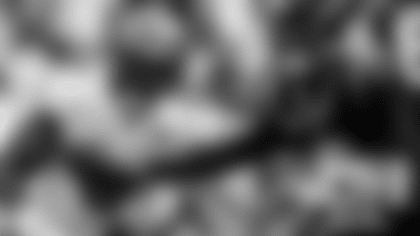The Answer Man has become a little more familiar with the NFL rulebook in recent weeks – perhaps more so than I ever wished – and I have a few observations about this densely-packed, 140-page manual:
- It's a dry read, to say the least, and extremely self-referential. You could spend hours following the notes from one rule extension (say, 8-2-10) to another (say 4-3-10, which you'll become acquainted with below). * It gives you a new appreciation for NFL officials, a reminder that perhaps we could all use at certain moments during any given Sunday afternoon broadcast. Learning the myriad specifics of some of these rules must be a painstaking process. Remembering them, while holding down a regular job the rest of the week, can't be easy. * If you've thought of it, so has the NFL.
Maybe these rule clarifications we've been discussing here in my column seem exotic to us, but chances are they've already been put in practice somewhere, sometime during the many thousands of previous NFL games. And the league is ready if they happen again.
For instance, the famous 'Holy Roller' play between the Oakland Raiders and San Diego Chargers in 1978 led to a change in the rulebooks, though not one as drastic as many believe. On that play, with time running out in a game the Chargers were leading 20-14, quarterback Kenny Stabler was about to be sacked when he purposely fumbled the ball forward to running back Pete Banaszak. Banaszak then intentionally scooped the ball forward again, towards the goal line, and after a few fortuitous bounces, it was recovered by Raider tight end Dave Casper for the game-winning touchdown.
Now, even at the time it was illegal for Stabler and Banaszak to intentionally fumble the ball forward. However, the officials were not able to determine at the time that either fumble was intentional (both players later admitted that they were), so the touchdown stood. After the season, the NFL took the guesswork out of the situation by amending Rule 8-4-2. As such, now the only offensive player who can advance a fumble in the last two minutes of either half is the same player who fumbled the ball, no matter how the fumble occurred.
So, basically, the 2004 Official Playing Rules of the National Football League, as it is officially entitled, has become a valuable if somewhat complicated tool for the Answer Man. It certainly came in handy in answering question number one below.
**
1. Amit Oberoi of Montreal, Quebec, Canada asks:
If time is running out of a game, and you are about to be tackled in bounds, are you allowed to lateral the ball (backwards, obviously) out of bounds? Will it be a penalty and an automatic 10 second runoff; I wouldn't see why. For the couple of yards you lose on a lateral, stopping the clock could be the difference between winning and losing.
Answer Man: Your suspicions are correct, Amit, and your game-saving gambit wouldn't work. The NFL obviously frowns on intentional fumbling – see the above 'Holy Roller' description – and has provisions for desperate acts such as these.
Rule 4-3-10 in the NFL rulebook condemns 'Actions to Conserve Time' and specifically mentions your suggestion. To wit:
A team is not permitted to conserve time inside of one minute of either half by committing any of the following acts: fouls by either team that prevent the snap (i.e., false start, encroachment, etc.), intentional grounding, an illegal forward pass thrown from beyond the line of scrimmage with the intent to conserve time, throwing a backward pass out of bounds with the intent to conserve time, and any other intentional foul that causes the clock to stop.
See? No go. Similarly, if the center was the first person to reach the spotted ball and he looked up to see the last few seconds running off the clock, he couldn't simply snap the ball before his team was set, hoping to draw a clock-stopping penalty. That would be the dreaded Action to Conserve Time.
The penalty, as you feared, includes a 10-second runoff. Again, here's how the rulebook puts it:
Penalty: Loss of five yards unless a larger distance penalty is applicable. When actions referred to above are committed by the offensive team with the clock running, officials will run 10 seconds off the game clock before permitting the ball to be put in play on the ready for the play signal. If the offensive team has timeouts remaining, it will have the option of using a timeout in lieu of a 10-second runoff…
And it goes on and on. But you get the point. Should you try this very risky intentional-fumble out of bounds, you would be slapped with a 10-second runoff and then the officials would start the clock again. Your only hope, I guess, is to heave the ball backwards as far as possible and hope a teammate can catch it.
**
2. Damon of Lakeland asks:
We all know of Brett Favre's impressive games-started streak. Who holds the Buccaneer all-time record for that? Or who has the longest current Buc streak? even if you decide not to post my question on the website, if you could email me with the answer(s) that would be wonderful....doubledizzle98@yahoo.com
Answer Man: This isn't the answer to your question, Damon, but did you know that midway into the 1999 season, when Favre's as-you-say impressive streak was at 115 games, the second-longest streak of starts among active NFL quarterbacks belonged to the Bucs' Trent Dilfer? Dilfer had a string of 70 straight starts going until it was snapped on Halloween in Detroit, as Eric Zeier was given the start.
Then again, I'm not called Useless Trivia Man, am I? (Don't answer that question.) Here is the answer to your question, Damon: Tony Mayberry.
The Bucs drafted Mayberry in the fourth round in 1990, and he actually started the first game of his career, a 38-21 Bucs win at Detroit to open the '90 season. Center Randy Grimes, the starter, had a biceps injury, but he returned to the lineup for the second game and stayed there the rest of the season.
That was only a brief delay for Mayberry, who won the job to start his second season and proceeded to play in and start every Buccaneer contest for the rest of the 1990s. It was 145 starts in all, 144 in a row to end his career. That is the Buccaneer record.
For now. Heading into the Oct. 10 New Orleans game, linebacker Derrick Brooks has a streak of 132 starts going and would tie Mayberry at 144 at the end of the season if he starts every contest. Health is obviously the only issue there, as the seven-time Pro Bowler is in no danger of losing his starting spot. And, historically, health hasn't been much of a problem for Brooks, who hasn't missed a single game in his 10-year career.
In fact, if not for that danged run-and-shoot craze of the early '90s, Brooks would already have the record. He earned a starting spot on the Bucs' defense from the get-go as a rookie in 1995, but was not on the field for the first snap on three occasions, as the Bucs faced run-and-shoot teams. In those contests, Tampa Bay's defense opened up in a nickel package and Brooks was the one linebacker to come out in that situation. Of course, he quickly became an every-down 'backer and has started every game since the beginning of the 1996 season.
The next two longest active games-started streaks among Buccaneers belong to tackle Todd Steussie (92, only the last four with Tampa Bay) and cornerback Ronde Barber (75, all with Tampa Bay).
**
3. Matt Holden of Tampa, Florida asks:
Hey, Answer Man! With Jacksonville off to a 3-0 start [Editor's Note: Now 3-1], people are starting to wonder about them a bit. We all know a team has never played in a Super Bowl in their own stadium. If such a thing happened, though, are there NFL rules in place for how to handle the situation? Namely, do the teams have to use neutral video board graphics, sideline displays, etc., or can they dress the stadium as if it's a home game?
Answer Man: As you undoubtedly know, Matt, the Buccaneers were hoping to press that issue themselves just a few years back, when Supe XXXV was held at Raymond James Stadium. Unfortunately, the Bucs had to wait two more years, but it was well worth it. And San Diego is an awfully nice place to form such lasting memories.
Anyway, the rules for such a game would be the same as always, because the Super Bowl is completely run by the league, not the hosting team. The scoreboard graphics, the field, the stadium decorations…all coordinated by league personnel.
The interesting question would be how partisan the crowd would prove to be. The ticket rules would not change, either; every team in the league gets a certain percentage of the seats to sell to their own fans, with the two participating teams obviously getting the largest shares by far. But the 'home' team would have no more tickets allotted to it than its opponent. Still, one imagines that, with travel and housing expenses taken out of the equation, a lot more of the 'home' team's fans would find a way to acquire tickets, which could lead to an obvious difference in the stands on game day.
Maybe the Jaguars can stay hot and give us all the answer in practice. And maybe the Bucs can get hot and we'll see what two teams in the general area of the stadium leads to.
**
4. Jaeden Stormes of Tampa, Florida asks:
Quickie one for you: Does the team that wins the Super Bowl get to keep the Lombardi Trophy each year, or does it get circulated like the Stanley Cup? If the teams get to keep them, where is the Bucs' trophy kept, and is it possible to get a picture of it in its current display?
Answer Man: Ah, got a theme going here.
I'm afraid you'd need an X-ray device to get an image of the Bucs' Lombardi Trophy in its current resting spot. At the moment, it is locked up safe, and Answer Man isn't going into specifics as to where.
Yes, Jaeden, each team gets its own full-size edition of the Lombardi Trophy. When it's handed to whatever madly-grinning coach and/or owner on the field after the game, it is inscribed with just 'Vince Lombardi Trophy' and 'Super Bowl (fill in the number), AFC vs NFC,' the words framing an embossed NFL logo. The championship team can then choose to have additional information engraved on the trophy, such as the game's date and score.
The Lombardi Trophies may not have the busy travel schedule and outlandish destinations of the Stanley Cup – truly an awesome trophy that is ALSO in Tampa at the moment – but it does make appearances. In some cases, a team will have a replica made for just such purposes, or for display at the team's headquarters, as a safety measure.
The Bucs' trophy is not currently on display. However, when the team moves into its state-of-the-art new facility in short time, you can bet that the Lombardi Trophy (or a replica, perhaps?) will be prominently displayed.
**
5. Shawn Abel of New Port Richey, Florida asks:
How is it determined what uniforms are worn on the field? I noticed in the last two home games that the Bucs wore their white jerseys. I thought those were their away jerseys.
Answer Man: We'll decide which ones are the quickies around here, alright Jaeden? This is one.
Anyway, Shawn, here's the thing: There are no 'home' and 'away' jerseys in the NFL. The home team does get to choose its jersey color, but they don't have to wear white, as is common in MLB, or their darker color, which is common in the NHL. The visiting teams have to wear the opposite – either their whites to offset the home team's colors, or vice versa.
Watch enough Buccaneer seasons and you'll catch the pattern. The team almost always wears white jerseys at home during the first half of the season for a simple reason: It's hot in Tampa. Wearing white forces your opponent to wear dark and, theoretically, have a slightly rougher time with the heat. Later in the year, you'll see the Bucs in red at home. By the way, this is determined at the beginning of the season, as teams send out lists to each other.
When the Bucs travel to venues where heat isn't as much of an issue, the hosting teams often wear their colored jerseys simply because they like the look. That puts the Bucs in white again. So, overall, you'll see a lot of the Bucs' white jerseys during the first two months of the season.
**
6. Todd Bartlett of St. Petersburg, Florida asks:
I was wondering if the Bucs were going to have Football 101 for the ladies this year. My wife went last year and loved it; is it coming up?
Answer Man: Well, Todd, I think your wife would probably test out of the entry-level course this year and have to enroll in Advanced Gridiron Dynamics or Origins of Football Theory.
As it turns out, however, there will be no school this fall. The very popular NFL 101 program, which was conducted last October with over 600 women in attendance, will not be held this season. The program is currently without a sponsor, but it may return in the future. I'm sure feedback such as yours will be weighed in the decision of whether or not to run Football 101 again.
**
'The Trip'
One of last week's discussions centered around the 'Palpably Unfair Act' (as we now know it's called) of a person on the sideline coming on the field and tripping or tackling a runner who was headed to the end zone.
I tracked down the answer as to how the officials would deal with such an occurrence, but not any examples of it actually happening in the NFL. The best I could do was a vague rumor referring to such an act in a Dallas Cowboys game in the 1960s or '70s. Saddened by my own failure, I asked for help finding an accurate and believable link to a description of that event.
Well, I'm still looking.
There were a few e-mails. A couple fans referred to the famous and somewhat humorous move by Pittsburgh Head Coach Bill Cowher in Jacksonville in 1997. Cowher stepped onto the field and raised a forearm as Jaguar Chris Hudson ran by on his way to the end zone with the recovered ball from a blocked field goal. Cowher didn't hit Hudson, but he did later admit that he thought about it. Darren S. Graf of Jacksonville described the incident well in his e-mail.
A fan from Kansas named Roy Rusch sent in a link, as requested, but it was to the Cotton Bowl incident in 1954 that Answer Man already described in adequate detail. It was a link to the Dallas incident for which I had asked.
Another fan named Terry Ewing from Virginia claimed the Dallas play involved Don Meredith and has been captured by NFL Films. That quickened the Answer Man's heart, as those were additional details that could help. Still, I could turn up nothing.
So the offer still stands. Find an accurate and believable link to the Dallas sideline trip story and I will send you a Buccaneers hat (to the first person who sends in the a good link).
**
Confidential to Jay of Laurel (Florida? Maryland? Delaware? North Carolina?):
Jay, you got us. The number on the depth chart was a mistake. Josh Savage wears 93, not 73. My friends here at Buccaneers.com have fixed the error.
I guess that really wasn't all that confidential, was it?


































